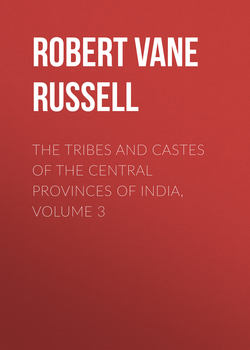Читать книгу The Tribes and Castes of the Central Provinces of India, Volume 3 - Robert Vane Russell - Страница 30
Gond
(b) Tribal Subdivisions
12. Exogamy
ОглавлениеThe Gond rules of exogamy appear to preserve traces of the system found in Australia, by which the whole tribe is split into two or four main divisions, and every man in one or two of them must marry a woman in the other one or two. This is considered by Sir J. G. Frazer to be the beginning of exogamy, by which marriage was prohibited, first, between brothers and sisters, and then between parents and children, by the arrangement of these main divisions.55
Among the Gonds, however, the subdivision into small exogamous septs has been also carried out, and the class system, if the surmise that it once existed be correct, remains only in the form of a survival, prohibiting marriage between agnates, like an ordinary sept. In one part of Bastar all the septs of the Māria Gonds are divided into two great classes. There are ninety septs in A Class and sixty-nine in B Class, though the list may be incomplete. All the septs of A Class say that they are Bhaiband or Dādabhai to each other, that is in the relation of brothers, or cousins being the sons of brothers. No man of Class A can marry a woman of any sept in Class A. The septs of Class A stand in relation of Māmabhai or Akomāma to those of Class B. Māmabhai means a maternal uncle’s son, and Akomāma apparently signifies having the same maternal grandfather. Any man of a sept in Class A can marry any woman of a sept in Class B. It will thus be seen that the smaller septs seem to serve no purpose for regulating marriage, and are no more than family names. The tribe might just as well be divided into two great exogamous clans only. Marriage is prohibited between persons related only through males; but according to the exogamous arrangement there is no other prohibition, and a man could marry any maternal relative. Separate rules, however, prohibit his marriage with certain female relatives, and these will be given subsequently.56 It is possible that the small septs may serve some purpose which has not been elicited, though the inquiry made by Rai Bahādur Panda Baijnāth was most careful and painstaking.
In another part of Bastar there were found to be five classes, and each class had a small number of septs in it. The people who supplied this information could not give the names of many septs. Thus Class A had six septs, Class B five, Classes C and D one each, Class E four, and Class F two. A man could not marry a woman of any sept belonging to his own class.
The Muria Gonds of Bastar have a few large exogamous septs or clans named in Hindi after animals, and each of these clans contains several subsepts with Gondi names. Thus the Bakaravans or Goat race contains the Garde, Kunjami, Karrami and Vadde septs. The Kachhimvans or Tortoise race has the Netāmi, Kawachi, Usendi and Tekāmi septs; the Nāgvans or Cobra race includes the Marāvi, Potāri, Karanga, Nurethi, Dhurwa and others. Other exogamous races are the Sodi (or tiger), Behainsa (buffalo), Netām (dog in Gondi), Chamchidai (bat) and one or two more. In this case the exogamous clans with Hindi names would appear to be a late division, and have perhaps been adopted because the meaning of the old Gondi names had been forgotten, or the septs were too numerous to be remembered.
In Chānda a classification according to the number of gods worshipped is found. There are four main groups worshipping seven, six, five and four gods respectively, and each group contains ten to fifteen septs. A man cannot marry a woman of any sept which worships the same number of gods as himself. Each group has a sacred animal which the members revere, that of the seven-god worshippers being a porcupine, of the six-god worshippers a tiger, of the five-god worshippers the sāras crane, and of the four-god worshippers a tortoise. As a rule the members of the different groups do not know the names of their gods, and in practice it is doubtful whether they restrict themselves to the proper number of gods of their own group. Formerly there were three-, two- and one-god worshippers, but in each of these classes it is said that there were only one or two septs, and they found that they were much inconvenienced by the paucity of their numbers, perhaps for purposes of communal worship and feasting, and hence they got themselves enrolled in the larger groups. In reality it would appear that the classification according to the number of gods worshipped is being forgotten, and the three lowest groups have disappeared. This conjecture is borne out by the fact that in Chhindwāra and other localities only two large classes remain who worship six and seven gods respectively, and marry with each other, the union of a man with a woman worshipping the same number of gods as himself being prohibited. Here, again, the small septs included in the groups appear to serve no purpose for regulating marriages. In Mandla the division according to the number of gods worshipped exists as in Chānda; but many Gonds have forgotten all particulars as to the gods, and say only that those septs which worship the same number of gods are bhaiband, or related to each other, and therefore cannot intermarry. In Betūl the division by numbers of gods appears to be wholly in abeyance. Here certain large septs, especially the Uika and Dhurwa, are subdivided into a number of subsepts, within each of which marriage is prohibited.
55
The theory is stated and explained in vol. iv. of Exogamy and Totemism.
56
See para. 15.
